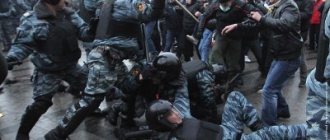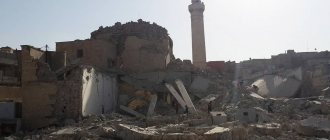ST 212 of the Criminal Code of the Russian Federation.
1. Organization of mass riots, accompanied by violence, pogroms, arson, destruction of property, the use of weapons, explosive devices, explosives, poisonous or other substances and objects that pose a danger to others, as well as armed resistance to a representative of the authorities, as well as training a person for organization such mass riots or participation in them -
shall be punished by imprisonment for a term of eight to fifteen years.
1.1. Inducing, recruiting or otherwise involving a person in committing actions provided for in part one of this article, -
shall be punishable by a fine in the amount of three hundred thousand to seven hundred thousand rubles, or in the amount of the wages or other income of the convicted person for a period of two to four years, or without it, or by forced labor for a term of two to five years, or by imprisonment for a term of five to five years. ten years.
2. Participation in mass riots provided for in part one of this article -
is punishable by imprisonment for a term of three to eight years.
3. Calls for mass riots provided for in the first part of this article, or for participation in them, as well as calls for violence against citizens -
shall be punishable by restriction of freedom for a term of up to two years, or forced labor for a term of up to two years, or imprisonment for the same term.
4. A person undergoes training that is known to the student to be carried out for the purpose of organizing mass riots or participating in them, including the acquisition of knowledge, practical skills and abilities during physical and psychological training classes, when studying methods of organizing mass riots, rules for handling weapons , explosive devices, explosives, poisonous substances, as well as other substances and objects that pose a danger to others -
shall be punishable by imprisonment for a term of five to ten years with or without a fine in the amount of up to five hundred thousand rubles or in the amount of the wages or other income of the convicted person for a period of up to three years.
Note. A person who has committed a crime provided for in part four of this article is exempt from criminal liability if he informed the authorities about undergoing training, which the student knew was conducted for the purpose of organizing mass riots or participating in them, contributed to the disclosure of the crime committed or the identification of other persons who have undergone such training. training, those who carried out, organized or financed such training, as well as the places where it was carried out and if his actions do not contain another crime.
Commentary to Art. 212 of the Criminal Code
1. From the point of view of the objective side of Art. 212 of the Criminal Code provides for five independent elements of crime.
The first of them is described in Part 1 as an action in the form of: a) organizing mass riots; b) preparing a person to organize mass riots or participate in them. Mass riots should be understood as generally disorderly, spontaneous actions of a significant number of people, consisting in the use of violence against other persons, pogroms (i.e. destruction and looting of residential buildings, premises, storage facilities), arson, destruction of property, senseless and untargeted use of weapons , explosive devices, explosives, toxic or other substances and objects that pose a danger to others, armed (i.e. accompanied by the use of weapons or the threat of their use) resistance to a representative of the authorities.
The organization of mass unrest includes actions aimed at initiating mass unrest, and further actions to lead (at least relative) and maintain mass unrest. Such actions may be the selection of initiators of crowd actions during mass riots, the development of a plan for the beginning and continuation of mass riots, leadership (at least relative) of participants in mass riots, etc.
Preparation of a person generally involves his education (see commentary to Articles 205.1, 205.3 of the Criminal Code).
2. The crime is considered completed from the moment the relevant organizational actions are committed, even if mass riots have not begun, or from the moment training begins, even if it is unsuccessful.
3. The second corpus delicti (Part 1.1) is the inducement, recruitment or other involvement of a person in committing actions provided for in Part 1 (see also the commentary to Article 205.1 of the Criminal Code).
4. The third element of the crime is described in Part 2 as participation in mass riots and consists of the direct commission of actions constituting mass riots.
5. The fourth corpus delicti (Part 3) is characterized by calls for mass riots, participation in them, or violence against citizens, i.e. single or repeated appeals to participants in mass riots or a wide range of outsiders in any form (orally, in writing, via communications; both anonymously and with the author indicated), aimed at encouraging the recipients of calls for active action.
The crime is considered completed from the moment the calls are made, regardless of whether it was possible to induce the recipients of the calls to take appropriate action.
6. The fifth element of the crime is characterized by a person undergoing training for the purpose of organizing mass riots or participating in them. A non-exhaustive list of learning activities is given in the article. The crime is over from the moment the person begins training.
7. The note to the article allows for the possibility of releasing a student from criminal liability in connection with his active repentance.
Second commentary to Art. 212 of the Criminal Code of the Russian Federation
1. The characteristic features of mass riots are:
a) mass character, i.e. participation in them of a significant number of persons (evaluative concept);
b) the spontaneity of the gathering of the masses and their weak controllability, which nevertheless does not exclude an organizational element in initiating mass unrest;
c) the illegality of a mass gathering or the escalation of a legally held public event into an illegal one, while the demands put forward by participants in mass riots or part of them may well be legitimate;
d) involving the use of violence against other persons, pogroms, arson, destruction of property, senseless and untargeted use of firearms, explosives or explosive devices, as well as armed resistance to a representative of the authorities.
The relative connection of the participants in the riots with a common idea, as well as the fact that mass riots act as a reaction to certain actions of the authorities, are not essential features of mass riots.
2. Violence means both physical and mental impact. Part 1 art. 212 provides for liability for organizing mass riots, therefore the harm that will be caused as a result must be subject to an independent criminal legal assessment.
Pogroms mean the destruction or looting of residential, office premises, vehicles, communications, etc., accompanied by destruction, damage.
Arson - actions that led to ignition or fires of buildings or other structures, cars and other means of transport. Arson is considered to have taken place regardless of whether the property was damaged, destroyed or not.
Destruction of property - rendering it completely unusable.
The use of firearms, explosives or explosive devices means their use to cause harm to human health, destruction of property, as well as the threat of using these items.
Providing armed resistance involves the direct use of weapons or the threat of their use against a representative of the authorities in order to prevent the restoration of order and the suppression of crowd outrages.
The use of violence against a representative of the authorities that is not dangerous to life or health when providing armed resistance, an encroachment on the life of a law enforcement officer or a military serviceman during mass riots requires additional qualification under Part 1 of Art. 318 or art. 317 of the Criminal Code, respectively.
The organization of mass riots consists of actions aimed at initiating them, directing the actions of the crowd (choosing the place and time of the riots, identifying from among the participants in the riots those responsible for individual actions, preparing propaganda posters, organizing communications), directing them to certain objects etc. The actions of an organizer of mass riots who took direct part in the mass riots themselves are fully covered by Part 1 of Art. 212 and do not require additional qualifications in conjunction with Part 2 of Art. 212.
The crime is considered completed from the moment of committing actions that constitute signs of organizing mass riots, accompanied by violence, pogroms, arson, destruction of property, use of firearms, etc., or from the moment of directing them. Actions to unite people to commit mass riots that do not lead to them should be qualified as an attempt to organize mass riots (Part 3 of Article 30 and Part 1 of Article 212).
3. Inducing, recruiting or otherwise involving a person in organizing or preparing a person to organize or participate in mass riots constitutes the actions of an instigator, which have received an independent criminal legal assessment. The crime will be considered completed at the moment when the person involved commits at least preparatory actions for the crime set out in Part 1 of Art. 212.
4. Participation in mass riots (Part 2) consists of directly committing actions that constitute mass riots.
The crime is considered completed from the moment any of the actions listed in Part 1 are committed (participation in violence, pogroms, arson, etc.).
5. Part 3 provides for liability for calls for mass riots or participation in them, as well as calls for violence against citizens.
Appeals are understood as a public appeal to an unlimited number of people in order to arouse their desire to perform certain actions. Appeals can be single, multiple, in written (leaflets, posters, etc.) and oral (speech at a rally, in the media, etc.) form.
The crime is considered completed from the moment the calls are made, regardless of whether they led to mass riots or participation in them or not.
6. In part of Part 4 of Art. 212 establishes responsibility for a person undergoing training that the student knows is carried out for the purpose of organizing mass riots or participating in them.
7. The subjective side of all crimes is characterized by direct intent.
8. The subject of the crime is a person who has reached the age of 16 years.
In cases where the culprit confines himself only to calls to a crowd or group of people and does not make efforts to organize mass unrest, he is held accountable under Part 3 of Art. 212. If there is incitement to mass riots, then it must be qualified under Part 2 of Art. 212 with reference to Part 4 of Art. 33 of the Criminal Code.
Complicity in mass riots, not accompanied by other organizational actions, must be qualified under Part 1 or 2 of Art. 212 with reference to Part 5 of Art. 33 of the Criminal Code.
9. In the note to Art. 212 establishes the conditions for exemption from criminal liability for a person who has committed a crime under Part 4 of Art. 212.
Mass riots: concept and criminal legal analysis of the crime.
Mass riots (Article 212 of the Criminal Code). The law states: “Organization of mass riots,
accompanied by
violence, pogroms, arson, destruction of property, the use of firearms, explosives or explosive devices, as well as armed resistance to a representative of the authorities, is punishable...”
Mass riots are a dangerous crime that violates public safety and can cause grave consequences, in which masses of people are involved. Mass riots are always the actions of a crowd, sometimes occurring spontaneously, sometimes carefully organized.
The main object of riots is public safety. Additional objects are the health and bodily integrity of citizens, as well as property.
The objective side of the crime lies in active actions. The criminal law provides for the following actions to create mass unrest: organizing mass unrest, participation in mass unrest, calls for active disobedience to the legal demands of government officials and for mass unrest, as well as calls for violence against citizens.
Organization of mass riots -
the most dangerous form of the crime in question consists of actions to incite aggressive moods among a mass of people, directing the crowd to commit violent acts, pogroms, and opposition to the authorities and law enforcement agencies.
Organizers direct the actions of the crowd, direct it to certain objects, put forward slogans that can electrify the crowd and cause its indignation.
Organizers can plan riots in advance and gradually prepare the mood of people by distributing leaflets, using the media, rallies, and campaigning in public places. However, there may be cases when, under the influence of some events (detention of offenders, non-payment of wages, power outages, lack of food delivery, etc.), organizers, using the indignation of people, incite them to commit mass riots.
Mass riots can arise on the basis of national or religious hostility, as was the case in Sumgayit, or on a political basis.
Mass riots in places of deprivation of liberty, when the organizers are the most dangerous convicts, the so-called crime bosses, pose a serious danger.
The crime is over
when mass riots occurred and violence against citizens, firearms, attempted pogroms, arson, etc. took place.
An attempt to excite the crowd and provoke it into mass riots, which did not lead to their occurrence, constitutes an attempt to organize mass riots.
Participation in riots
involves active actions (the use of violence, weapons, committing arson, participation in a pogrom, providing armed resistance to government officials).
The use of violence can be expressed in beating people, raping women, or causing harm to the health of citizens. The commission of murders during mass riots must be qualified in aggregate under Art. 212 and art. 105 of the Criminal Code of the Russian Federation.
Pogrom
means destruction or damage to residential and office premises, destruction of equipment and household items, intentional destruction and damage to property.
Armed resistance
to government officials means the direct use of firearms or bladed weapons or the threat of the use of weapons addressed to government officials in order to prevent them from restoring order or suppressing mass unrest.
Finished
a crime in the form of participation in mass riots will begin from the moment of the use of violence, weapons, attempted arson, pogrom.
Persons who were part of the crowd, but did not take part in pogroms, arson, use of violence and weapons, even if they shared the mood of the crowd, responsibility for participation
are not carried out in riots. They will be witnesses in the case of mass riots.
Calls for active disobedience to the legal demands of government officials and for mass riots, as well as calls for violence against citizens
are expressed in agitation aimed at arousing discontent and aggressive sentiments among an indefinite number of people. Appeals can be expressed in the expression of illegal aggressive ideas at meetings, in the writing and distribution of written materials containing such ideas.
Calls for violence should not be directed against specific individuals, but against any population groups on national, social, or religious grounds.
In contrast to an attempt to organize mass unrest, calls for violence against citizens, mass unrest and active disobedience to the legal demands of government officials are, as it were, incitement to possible mass unrest in the future.
The subject of all forms of crimes provided for in Art. 212 of the Criminal Code, there may be persons over 16 years of age.
The subjective side of the crime is expressed in the form of direct intent,
the content of which includes the consciousness that a person organizes a crowd or acts as part of a crowd that commits pogroms, arson, violence against citizens, and armed resistance to government officials. A person organizing mass riots or actively participating in them wants to commit the specified actions.
Motives
mass riots can be anything, for example, anger at the actions of the authorities, national and religious enmity, self-interest, when during mass riots and pogroms looting of shops, warehouses, apartments, etc. occurs.
The motive for the crime does not affect the qualification of the crime, but can be taken into account when assigning a penalty.
30. Hostage taking: criminal legal characteristics, distinction from kidnapping.
Taking a hostage (Article 206 of the Criminal Code). Liability for hostage-taking was first introduced in 1987 (Article 1261 of the Criminal Code of the RSFSR). This article was placed in the chapter “Crimes against life, health and dignity of the individual.” In the Criminal Code of the Russian Federation, Art. 206 is found in ch. 24 - “Crimes against public safety.”
The crime is defined by law as follows: “The taking or holding of a person as a hostage, committed for the purpose of compelling a state, organization or citizen to do or refrain from doing any act as a condition for the release of the hostage.”
The object of the crime is public safety, as well as life, health, freedom and bodily integrity of the individual.
Hostage-taking, which took place in international practice after the Second World War, arose in our country as a criminal phenomenon only in the mid-80s.
Hostage-taking was often practiced for political purposes and was of an interstate nature, when citizens of one country took citizens of another state as hostages. Therefore, hostage taking can be considered not only as a domestic crime, but also as an international crime. It is no coincidence that the fight against hostage-taking was provided for by the Convention adopted by the UN General Assembly in 1979.
Taking hostages falls under the definition of an international crime,
given by Professor I. I. Karpets: “Crimes of an international nature are acts provided for by agreements (conventions), not related to crimes against humanity, but encroaching on normal relations between states, detrimental to peaceful cooperation in various areas of relations (economic, social, cultural, property, etc.), as well as organizations and citizens, punishable either according to the norms established in international agreements (conventions), ratified in the prescribed manner, or according to the norms of national criminal legislation in accordance with these agreements”*.
Hostage-taking can occur both as a domestic criminal act and as an international crime affecting the interests of several states.
The objective side of the crime consists of active actions in the form of capturing or holding one person or several persons as hostages.
Hostage taking
consists of the unlawful deprivation of liberty of one or more persons, coupled with violence or the threat of violence. The seizure may be accompanied by the transfer of hostages from their location to another, sometimes specially prepared place.
Face hold
as a hostage means forcibly preventing a person from leaving the premises in which he was located, for example, an office of an institution, a bank premises, a train station or an airport, etc. Violence can be expressed in beatings, blows, tying up and other actions that do not pose a threat to life or health.
From the objective side, the capture or retention of a hostage must be accompanied by a certain requirement,
an appeal to the state, any organization or individual citizens. This requirement may concern the performance of any actions, for example, the release of imprisoned persons, the withdrawal of troops from a certain region, the lifting of a state of emergency, the provision of transport to leave the country, the payment of a ransom for the release of hostages, the termination of a criminal case, etc. P.
Criminals may also demand failure to perform any actions, for example, failure to initiate criminal prosecution of certain individuals, failure to conduct operations to search for places where drugs are manufactured and stored, failure to sign any documents, etc.
The taking of hostages and the presentation of demands are often demonstrative in nature, accompanied by notification to the media.
When demands are addressed to the state, they are sent to official bodies. The taking of hostages may occur in one country, and the demands may be made on another country.
In Russia, hostage-taking has repeatedly occurred in order to obtain large sums of money, weapons and drugs and to provide transport for escaping from Russia and was most often carried out by criminals, sometimes escaping from places of detention.
The crime is over
from the moment of deprivation of liberty of persons considered as hostages. There may be a time gap between the taking of hostages and the presentation of specific demands.
The subject of a crime can be a sane person who has reached the age of 14.
The subjective side of the crime is characterized by direct intent. The subject is aware that. forcibly deprives a person or several persons of freedom in order to put forward demands to the state, organizations or individual citizens, and wishes in this way to achieve satisfaction of their demands. Motivation for the crime under Part 1 of Art. 206, does not matter for qualification.
As an aggravating circumstance, a certain motivation is provided for in Part 2 of the article in question.
In Part 2 of Art. 206 of the Criminal Code provides for the following qualified types of hostage-taking: a) commission of an act by a group of persons by prior conspiracy; b) repeatedly; c) with the use of violence dangerous to life or health; d) using weapons or objects used as weapons; e) in relation to a known minor; f) in relation to a woman who is known to the perpetrator to be pregnant; g) in relation to two or more persons; h) for selfish reasons or for hire.
The signs provided for in paragraphs “a” - “d” are considered in the analysis of crimes against property. Points “d” and “f” indicate the special characteristics of the victims (age, pregnancy), an attack on which poses an increased danger. In this case, the subject must be aware that he is taking a minor or a pregnant woman as a hostage.
two or more persons as a hostage also poses an increased danger
Such an act often occurs when not a specific person is taken hostage, but all people present in a certain place (vehicle, office premises or other public place).
The only motive provided by law as a qualifying circumstance is self-interest. Self-interest can be expressed in the desire to receive a ransom or other material benefit for the release of hostages or the commission of a given crime for hire, that is, for payment.
In Part 3 of Art. 206 provides for liability for hostage-taking under especially aggravating circumstances. Such circumstances are : the commission of a crime by an organized group or an act that entailed
negligence
death of a person or other serious consequences. The death of a person can be caused as a result of the use of violence, for example, when the victim, who was gagged, suffocated, died of a heart attack;
being subjected to violence during capture, died trying to escape from criminals, fell from a height, etc. Under other grave consequences
should be understood as a vehicle accident, the occurrence of a fire, panic among a mass of people and the receipt of injuries and injuries to persons, disruption of transport traffic, such as aviation, causing major material damage, etc.
The subjective attitude of the perpetrators to the death of a person or other grave consequences should only be careless in the form of both frivolity and negligence.
Intentional causing of death to hostages, persons who tried to free them, or other persons must be qualified in their entirety under Art. 206 and Art. 105 of the Criminal Code.










